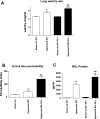A paradoxical protective role for the proinflammatory peptide substance P receptor (NK1R) in acute hyperoxic lung injury
- PMID: 19633070
- PMCID: PMC2770780
- DOI: 10.1152/ajplung.90509.2008
A paradoxical protective role for the proinflammatory peptide substance P receptor (NK1R) in acute hyperoxic lung injury
Abstract
The neuropeptide substance P manifests its biological functions through ligation of a G protein-coupled receptor, the NK1R. Mice with targeted deletion of this receptor reveal a preponderance of proinflammatory properties resulting from ligand activation, demonstrating a neurogenic component to multiple forms of inflammation and injury. We hypothesized that NK1R deficiency would afford a similar protection from inflammation associated with hyperoxia. Counter to our expectations, however, NK1R-/- animals suffered significantly worse lung injury compared with wild-type mice following exposure to 90% oxygen. Median survival was shortened to 84 h for NK1R-/- mice from 120 h for wild-type animals. Infiltration of inflammatory cells into the lungs was significantly increased; NK1R-/- animals also exhibited increased pulmonary edema, hemorrhage, and bronchoalveolar lavage fluid protein levels. TdT-mediated dUTP nick end labeling (TUNEL) staining was significantly elevated in NK1R-/- animals following hyperoxia. Furthermore, induction of metallothionein and Na(+)-K(+)-ATPase was accelerated in NK1R-/- compared with wild-type mice, consistent with increased oxidative injury and edema. In cultured mouse lung epithelial cells in 95% O(2), however, addition of substance P promoted cell death, suggesting the neurogenic component of hyperoxic lung injury is mediated by additional mechanisms in vivo. Release of bioactive constituents including substance P from sensory neurons results from activation of the vanilloid receptor, TRPV1. In mice with targeted deletion of the TRPV1 gene, acute hyperoxic injury is attenuated relative to NK1R-/- animals. Our findings thus reveal a major neurogenic mechanism in acute hyperoxic lung injury and demonstrate concerted actions of sensory neurotransmitters revealing significant protection for NK1R-mediated functions.
Figures









Similar articles
-
Inhibition of extracellular HMGB1 attenuates hyperoxia-induced inflammatory acute lung injury.Redox Biol. 2014 Jan 20;2:314-22. doi: 10.1016/j.redox.2014.01.013. eCollection 2014. Redox Biol. 2014. PMID: 24563849 Free PMC article.
-
Sex-specific differences in hyperoxic lung injury in mice: implications for acute and chronic lung disease in humans.Toxicol Appl Pharmacol. 2013 Oct 15;272(2):281-90. doi: 10.1016/j.taap.2013.06.007. Epub 2013 Jun 21. Toxicol Appl Pharmacol. 2013. PMID: 23792423 Free PMC article.
-
Mice deficient in the gene for cytochrome P450 (CYP)1A1 are more susceptible than wild-type to hyperoxic lung injury: evidence for protective role of CYP1A1 against oxidative stress.Toxicol Sci. 2014 Sep;141(1):68-77. doi: 10.1093/toxsci/kfu106. Epub 2014 Jun 3. Toxicol Sci. 2014. PMID: 24893714 Free PMC article.
-
Inflammation and Organ Injury the Role of Substance P and Its Receptors.Int J Mol Sci. 2023 Mar 24;24(7):6140. doi: 10.3390/ijms24076140. Int J Mol Sci. 2023. PMID: 37047113 Free PMC article. Review.
-
Neurokinin-1 receptor: functional significance in the immune system in reference to selected infections and inflammation.Ann N Y Acad Sci. 2011 Jan;1217:83-95. doi: 10.1111/j.1749-6632.2010.05826.x. Epub 2010 Nov 22. Ann N Y Acad Sci. 2011. PMID: 21091716 Free PMC article. Review.
Cited by
-
The role of afferent pulmonary innervation in ARDS associated with COVID-19 and potential use of resiniferatoxin to improve prognosis: A review.Med Drug Discov. 2020 Mar;5:100033. doi: 10.1016/j.medidd.2020.100033. Epub 2020 Apr 4. Med Drug Discov. 2020. PMID: 32292906 Free PMC article. Review.
-
Lung endothelial HO-1 targeting in vivo using lentiviral miRNA regulates apoptosis and autophagy during oxidant injury.FASEB J. 2013 Oct;27(10):4041-58. doi: 10.1096/fj.13-231225. Epub 2013 Jun 14. FASEB J. 2013. PMID: 23771928 Free PMC article.
-
Marked Effects of Tachykinin in Myositis Both in the Experimental Side and Contralaterally: Studies on NK-1 Receptor Expressions in an Animal Model.ISRN Inflamm. 2013 Jan 29;2013:907821. doi: 10.1155/2013/907821. eCollection 2013. ISRN Inflamm. 2013. PMID: 24049666 Free PMC article.
-
Increased hyperoxia-induced lung injury in nitric oxide synthase 2 null mice is mediated via angiopoietin 2.Am J Respir Cell Mol Biol. 2012 May;46(5):668-76. doi: 10.1165/rcmb.2011-0074OC. Epub 2012 Jan 6. Am J Respir Cell Mol Biol. 2012. PMID: 22227562 Free PMC article.
-
C5L2, the Second C5a Anaphylatoxin Receptor, Suppresses LPS-Induced Acute Lung Injury.Am J Respir Cell Mol Biol. 2016 Nov;55(5):657-666. doi: 10.1165/rcmb.2016-0067OC. Am J Respir Cell Mol Biol. 2016. PMID: 27285858 Free PMC article.
References
-
- Asehnoune K, Strassheim D, Mitra S, Kim JY, Abraham E. Involvement of reactive oxygen species in Toll-like receptor 4-dependent activation of NF-kappa B. J Immunol 172: 2522–2529, 2004 - PubMed
-
- Barazzone C, Horowitz S, Donati YR, Rodriguez I, Piguet PF. Oxygen toxicity in mouse lung: pathways to cell death. Am J Respir Cell Mol Biol 19: 573–581, 1998 - PubMed
-
- Bill A, Stjernschantz J, Mandahl A, Brodin E, Nilsson G. Substance P: release on trigeminal nerve stimulation, effects in the eye. Acta Physiol Scand 106: 371–373, 1979 - PubMed
Publication types
MeSH terms
Substances
Grants and funding
LinkOut - more resources
Full Text Sources
Other Literature Sources
Molecular Biology Databases

